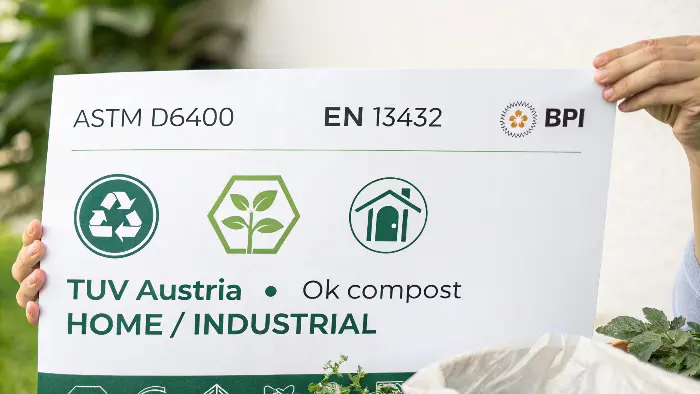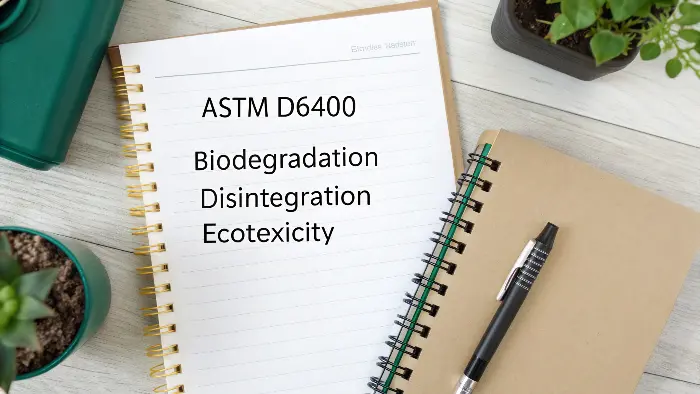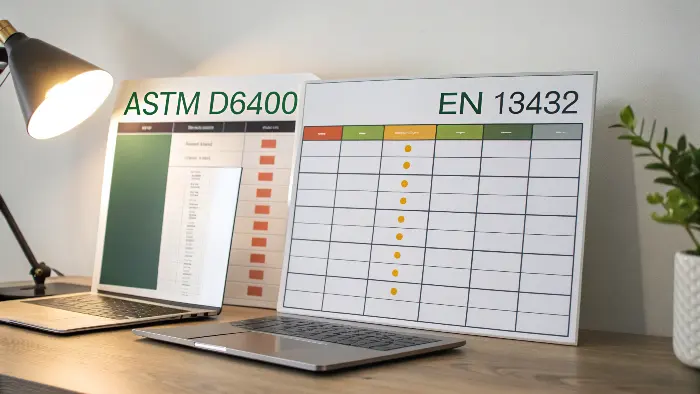Tired of confusing eco-labels for your coffee shop supplies? Greenwashing makes choosing genuinely compostable items tricky. So, let’s dig into key certifications and build some real trust.
The bottom line is: understanding compostable certifications means knowing which standards (like ASTM D6400 or EN 13432) prove items truly break down in specific conditions. This helps your coffee shop make genuinely eco-friendly choices, not just wishful ones.
Figuring out these certifications can feel like navigating a dense forest sometimes, right? I remember when I first started looking into this for Ecosourcecn, my head was spinning a bit with all the acronyms and numbers. But honestly, once you get the hang of the main players and what they stand for, it all starts to click into place. So, let’s break it down further, shall we? It’s actually not as scary as it sounds, and getting it right is super important for us, our planet, and for our customers like Jacky who are counting on genuine solutions.
What does "certified compostable" mean, really?
Seen "compostable" claims on everything lately? Many aren’t backed by solid proof, leading to those pesky greenwashing worries. Let’s clarify what "certified compostable" truly guarantees for your business.
Essentially, "certified compostable" means a product is independently verified by a third party to break down into natural elements. This happens within a specific timeframe under controlled composting conditions, meeting established standards like ASTM D6400 or EN 13432.
So, when you spot that "certified compostable" label, it’s not just some marketing fluff. It means the product has actually gone through some pretty rigorous testing. Think of it like this: an independent organization, a third-party, has put that item through its paces to see if it genuinely breaks down the way it’s supposed to. They don’t just toss it in a backyard compost bin and cross their fingers! These tests are typically designed for industrial composting facilities – those big operations that can create the perfect storm of heat, moisture, and hungry microorganisms needed for proper decomposition. I once visited a facility, and the scale of it, and the science involved—wow, it was impressive!
For us at Ecosourcecn, this third-party validation is absolutely critical. We want to be 100% sure that the products we offer, whether it’s our popular PLA cold cups or our sturdy bagasse food containers, genuinely meet these stringent standards. It all boils down to trust, you know? Our clients, especially sharp folks like Jacky in Canada who are really on top of their sustainability game, depend on these certifications. They need that assurance that the "eco-friendly" supplies they’re investing in for their coffee shop aren’t just going to end up being another problem for landfills.
Here’s a bit more insight into what "certified compostable" usually involves for a product to pass:
- Material Safety Check: The product absolutely must not release any harmful substances as it breaks down. We’re talking no heavy metals or other nasty toxins leaching into the compost.
- Biodegradation Level: A very high percentage of the material – typically over 90% – has to convert into carbon dioxide, water, and biomass. This has to happen within a set period, often around 180 days in controlled conditions.
- Disintegration Test: After about 12 weeks in a composting environment, the product should practically vanish. It needs to break down into tiny pieces, small enough that very little residue is left when sifted through a 2mm screen. You shouldn’t be finding big, recognizable chunks.
- Plant Growth Test (Ecotoxicity): The compost produced from the material must be beneficial for plant life, not harmful. They actually test this to ensure it doesn’t stunt growth or poison the soil.
It’s quite an ordeal for a product to go through! So, "certified" means it’s successfully jumped through all these hoops. It’s a stamp of approval that essentially says, "Yep, this item will compost as advertised, if it’s sent to the correct facility." This is worlds away more reliable than just seeing "biodegradable" vaguely printed on something, which, let’s be honest, can mean almost anything, or sometimes, disappointingly, nothing at all!So, what is the actual certification for compostable items then?
Feeling unsure about which eco-labels to truly put your faith in? So many vague claims can cause confusion and hinder real sustainable choices. Let’s pinpoint the key certifications that genuinely matter.
The main, most recognized certifications for compostable items are ASTM D6400 (predominantly used in North America) and EN 13432 (the standard for Europe). Other important ones include BPI certification (often linked to ASTM D6400) and TÜV AUSTRIA’s OK compost HOME/INDUSTRIAL marks.

Alright, so we’ve established that "certified compostable" is the gold standard. But what are these actual certifications called? It’s not just one universal magic label, unfortunately – that would make our lives way too easy, haha! Different parts of the world tend to have their own main standards, though they often share very similar goals and testing principles. It’s a bit like how different countries have different electrical outlets, but the electricity itself is doing the same job.
Think of it like this: if you’re sourcing compostable coffee cups for a café chain in North America, you’ll constantly hear about ASTM D6400. This is a huge one in the United States and Canada. If your business focus is more on the European market, then EN 13432 is the standard you’ll need to be familiar with. These are the technical "rulebooks" that products have to meet to prove their compostability.
Then, you have the certifying bodies. These are the independent organizations that actually conduct (or oversee) the testing and then, if the product passes, award the official certification labels. For instance, the Biodegradable Products Institute (BPI) is incredibly well-known and respected in North America. If a product boasts BPI certification, it means it has successfully met the requirements of ASTM D6400 (or sometimes ASTM D6868, which is for compostable coatings on paper products). You’ll see their distinctive BPI logo on a lot of compostable packaging. It’s a pretty reliable indicator that you’re looking at a legitimately compostable item. I remember when we first started sourcing PLA cutlery years ago; ensuring our suppliers had BPI certification was a non-negotiable. It just makes everything so much smoother for our clients, like Jacky, who need that clear verification.
Over in Europe, TÜV AUSTRIA is a major certifying body. They issue the "OK compost INDUSTRIAL" mark (which signifies compliance with EN 13432) and also an "OK compost HOME" mark. The "HOME" one is for items that can break down in a typical backyard compost bin – this is a bit different and generally applies to thinner materials or specific product types, as home composts don’t reach the high, consistent temperatures of industrial facilities.
So, to sum it up, the "certification" you’re looking for is really a combination of:
- The Standard: This is the detailed technical specification or rulebook (e.g., ASTM D6400, EN 13432).
- The Certifying Body: This is the impartial judge or referee that does the testing and grants the certification (e.g., BPI, TÜV AUSTRIA).
- The Mark/Logo: This is the official stamp of approval that you see on the product, signaling it has passed.
It’s super important to look for these official marks from recognized bodies, not just the word "compostable" printed by the manufacturer themselves without any backup. It’s all about that crucial third-party verification. At Ecosourcecn, we always encourage, and often require, our suppliers to obtain these recognized certifications because it provides peace of mind for everyone in the chain – from us to our clients, and ultimately to the end-consumer.Can you tell me more about the ASTM standard for composting?
Feeling a bit bamboozled by ASTM D6400? This standard is absolutely key for North American compostables, but it can seem pretty technical at first glance. Let’s simplify what ASTM D6400 means for your products.
ASTM D6400 is the principal North American standard specification for plastics and products made from plastics that are designed to be aerobically composted in municipal or industrial facilities. It clearly defines criteria for biodegradation, disintegration, and ecotoxicity.

Okay, let’s really zoom in on ASTM D6400. If your business operates in North America, or you’re sourcing products for that market – like our colleague Jacky in Canada – this is a standard you’ll encounter frequently. The full, rather grand title is "Standard Specification for Labeling of Plastics Designed to be Aerobically Composted in Municipal or Industrial Facilities." It’s a bit of a mouthful, eh? So, understandably, everyone just calls it ASTM D6400.
In essence, this standard lays down the rules for plastics (and items made from them) that are intended to break down properly in large-scale, professionally managed composting sites. It’s important to note, this generally doesn’t mean your typical home compost bin. Industrial facilities are a different ball game; they can achieve much higher and more consistent temperatures, and the whole process is more rigorously controlled. I once worked with a new supplier who thought "compostable" meant "toss it in the garden." We had a long chat about ASTM D6400 that day!
Here’s a breakdown of what a product needs to achieve to meet the ASTM D6400 standard:
- Disintegrate Thoroughly: The product must break down into very small pieces. Specifically, after 84 days (which is 12 weeks) in a controlled composting test environment, less than 10% of the original material should be left behind when sifted through a 2mm screen. So, it needs to physically fall apart and practically disappear.
- Biodegrade Chemically: The plastic components need to be consumed and processed by microorganisms. Within a maximum of 180 days, at least 90% of the organic carbon present in the plastic must be converted into carbon dioxide. This is verified using a specific laboratory test (ASTM D5338). This part proves that the material is actually returning to natural elements, not just breaking into microplastics.
- Leave No Harmful Residues: The composting process itself shouldn’t create any toxic byproducts. The standard sets strict limits for various heavy metals. Furthermore, the final compost produced must be safe and beneficial for plant growth – they actually conduct tests (ecotoxicity tests) to make sure the compost doesn’t negatively impact plant health or soil quality.
It’s a pretty demanding set of criteria! When we at Ecosourcecn are evaluating new compostable coffee cups, lids, straws, or cutlery for the North American market, a top priority is ensuring our suppliers can provide clear evidence that their products meet ASTM D6400. Often, this means they are BPI certified, as BPI uses ASTM D6400 as the core of its certification program. This standard is a crucial checkpoint for us, allowing us to confidently provide genuinely compostable solutions. It’s not just about making a claim; it’s about demonstrating proven, repeatable performance. Think about it – a coffee shop owner needs to be absolutely confident that the "compostable" cups they provide to customers will actually break down as expected if they are correctly diverted to an appropriate composting facility. ASTM D6400 helps provide that essential confidence.What’s the difference between ASTM D6400 and EN 13432 then?
ASTM D6400 versus EN 13432 – it can seem a bit confusing, right? Both are major standards for certifying compostables, but key differences exist that are important for global sourcing. Let’s compare these crucial standards for better clarity.
ASTM D6400 (the North American standard) and EN 13432 (the European standard) are very similar in their goals for industrial compostability. Key differences can include specific disintegration timelines or testing nuances, heavy metal limits, and precise biodegradation testing methods, though both ultimately aim for safe and effective composting.
 So, we have ASTM D6400 primarily for North America and EN 13432 as the go-to standard in Europe. You can think of them as close cousins – they come from the same family, share similar objectives, but each has its own distinct characteristics and little quirks. Both standards are designed for products intended for industrial composting facilities, not usually for home composting. If you’re involved in sourcing products internationally, as we are at Ecosourcecn, having a good grasp of the main differences (and similarities!) between these two is incredibly useful. It helps us guide our clients, like Jacky, to make the best choices for their specific markets. Here’s a simplified table to highlight some of the main points of comparison: |
Feature | ASTM D6400 (North America) | EN 13432 (Europe) |
|---|---|---|---|
| Primary Region of Use | North America (USA, Canada) | Europe | |
| Disintegration Time | Less than 10% material left on a 2mm sieve after 84 days (12 weeks) | Less than 10% material left on a 2mm sieve after 12 weeks (84 days) | |
| Biodegradation Level | Minimum 90% conversion of organic carbon to CO2 within 180 days | Minimum 90% conversion of organic carbon to CO2 within 180 days (or 90% relative to a reference material) | |
| Heavy Metals Limits | Specifies limits for a defined list of heavy metals | Specifies limits for a defined list of heavy metals (list and limits can slightly vary) | |
| Ecotoxicity Tests | Must pass plant growth tests and chemical analysis | Must pass plant growth tests and chemical analysis (specific test protocols might differ) | |
| Volatile Solids Content | Product must contain at least 50% volatile (organic) solids. | Not explicitly stated in the same way, but organic carbon requirements imply a high organic content. | |
| Specific Chemical Limits | Focus on heavy metals. | Includes limits for fluorine content, in addition to heavy metals. |
As you can see from the table, they are largely in alignment on the core principles. Both demand that products break down physically (disintegration) and chemically (biodegradation) and, crucially, that they don’t leave any harmful residues behind in the compost. The timelines for biodegradation and disintegration are practically identical. The main differences often crop up in the specific laboratory test methods that are cited within the standards, the exact list of regulated heavy metals and their permissible limits, and sometimes subtle variations in how ecotoxicity testing is conducted or evaluated. For instance, EN 13432 explicitly includes a limit for fluorine content, which isn’t a specific point in ASTM D6400.
For a company like Ecosourcecn, which sources and supplies globally, this matters. When we are evaluating a new compostable material, let’s say a new type of PLA-based film for packaging, we’d ideally look for manufacturers who have test reports demonstrating compliance with both standards if we intend to offer that product in both North American and European markets. It just makes life simpler for our clients. Someone like Jacky might be comparing products from different regions or might have a business that operates in multiple countries, so having products certified to the relevant local standard is key. Sometimes, a product certified to one standard will largely meet the requirements of the other, but it’s always best practice to have the specific certification for the target market. It’s a bit like needing a different power plug adapter when you travel – the electricity does the same thing, but you need the right connector for the local socket! 😉 This diligence ensures transparency and reliability for everyone.
Conclusion
Ultimately, choosing certified compostable supplies means your coffee shop genuinely backs sustainability. This builds deep trust with your eco-aware customers – and that’s priceless! It’s worth the effort. 🔥


